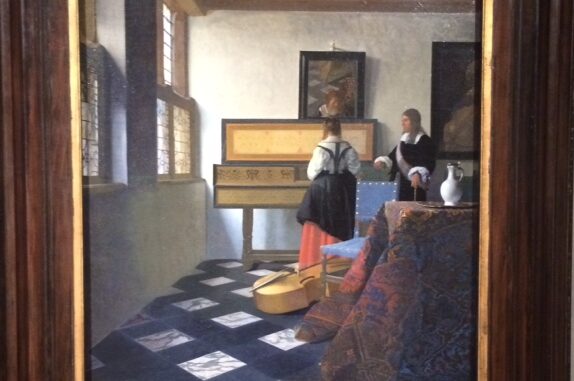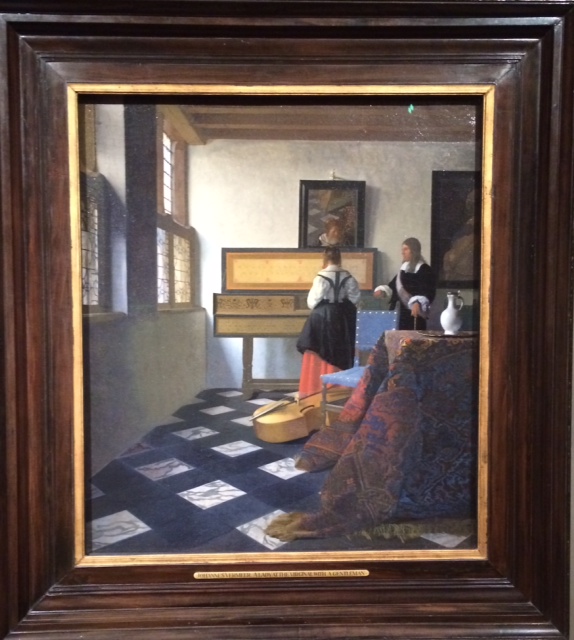
To the Queen’s Gallery for two new exhibitions. Masters of the Everyday: Dutch artists in the Age of Vermeer and High Spirits: The Comic Art of Thomas Rowlandson (review coming) together demonstrate the amazing depth and breadth of the Royal collection. If the English had followed the French example these works would now belong to the nation – or have been destroyed in a fiery uprising – but instead of chopping off heads our revolutionaries upped-sticks and moved to America so the Queen still has a huge collection. Lucky lady, although I’m not sure how often she visits her eponymous gallery; she’s certainly never been there when I’ve visited.
The curators at the Queen’s Gallery always do a fine job of choosing highlights from the collection and showing them in well-displayed and informative ways. For these two exhibitions (accessible with one ticket) Desmond Shawe-Taylor & Quentin Buvelot (who have curated Masters of the Everyday) and Kate Heard (who has curated High Spirits) have again produced well-structured shows, divided into sections that elucidate different ideas and themes – whether Rowlandson’s attacks on the Duke of York or different niches of Dutch genre painting. There is always a learning room which makes the exhibitions fun for children, usually with dressing up clothes and games. (Anyone fancy a quick round of Morra?) This time it is definitely worth going in the learning room as there is a large graphic on the wall explaining some of the symbolism in the Dutch paintings you will see in the show.

Johannes Vermeer (Delft 1632-Delft 1675)
A Lady at the Virginals with a Gentleman, c.1662-5
A false grey wall has been placed around the main gallery. This is an attempt to increase intimacy and bring the scale of the room and the colour of the background closer to that of the 17th century Dutch interiors that are shown in the paintings. These include twenty-seven masterpieces from artists such as Gerrit Dou (rated above Rembrandt by early connoisseurs), Gabriel Metsu, Jan Steen and Pieter de Hooch. The current most fashionable star artist of the period is represented by Lady at the Virginals with a Gentleman – no cryptic titles for Johannes Vermeer. For years this picture languished unloved in the Royal collection, presumably curators thinking it’s just a woman standing with her back to us. Vermeer is a man happy to use the expensive Lapis Lazuli in his black floor tiles. Strangely extravagant with a peculiar mis en scene, it has an oddly sexual tension, exaggerated by a double bass carelessly thrown on the floor. This gives a suggestive undertone to an experiment in the capture of subtle light.
Dutch paintings of peasant revels are well represented in the show. These images of Rude Mechanicals and their drinking, carousing and seducing are supposed to be humorous, but as they were made for much wealthier people than those depicted they inherently contain too much prurient ridicule. They show ‘real life’ as a hive of vice and escapism. The work of Jan Steen and the other genre artists is precise and the individual characters are clearly well observed and skilfully rendered. The effect can be read as photojournalism’s earlier cousin painting-journalism. But it feels more like heightened mockery.
This was a time when artists had absorbed the lessons of perspective and light and their works were no longer the reserve of kings and courtiers. Great representational skill is demonstrated throughout, especially by Pieter de Hooch in Card players in a sunlit room. His superb technique allows light to emanate from an internal courtyard, leaving the figure nearest the viewer almost in silhouette. It is a remarkable achievement.
Be Warned: It’s a common ploy amongst museums to stick the name of the most famous artist in the show in the exhibition’s title, even if there are very few of his works in the exhibition. The Queen’s Gallery has followed this lead and even though his name takes pride of place in the title there is only the one Vermeer in the show. There’s a gaggle of Rembrandts so you’ll be happy enough if you go to check off big names, but there is also great ability demonstrated by lesser artists. The works in the main Dutch gallery feel as though they were painted by observers rather than participants, even if the odd self-portrait turns up amongst the revellers. They lack real emotion but they are finely detailed and demonstrate exquisite craftsmanship.
Friday, 13 November 2015 to Sunday, 14 February 2016

Leave a Reply